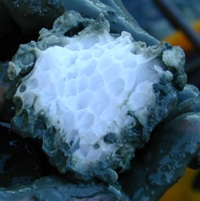New method to prevent undersea ice clogs
13 Apr 2012
During the massive oil spill from the ruptured Deepwater Horizon well in 2010, it seemed at first like there might be a quick fix: a containment dome lowered onto the broken pipe to capture the flow so it could be pumped to the surface and disposed of properly. But that attempt quickly failed, because the dome almost instantly became clogged with frozen methane hydrate.
 Methane hydrates, which can freeze upon contact with cold water in the deep ocean, are a chronic problem for deep-sea oil and gas wells. Sometimes these frozen hydrates form inside the well casing, where they can restrict or even block the flow, at enormous cost to the well operators.
Methane hydrates, which can freeze upon contact with cold water in the deep ocean, are a chronic problem for deep-sea oil and gas wells. Sometimes these frozen hydrates form inside the well casing, where they can restrict or even block the flow, at enormous cost to the well operators.
Now researchers at MIT, led by associate professor of mechanical engineering Kripa Varanasi, say they have found a solution, described recently in the journal Physical Chemistry Chemical Physics. The paper's lead author is J David Smith, a graduate student in mechanical engineering.
The deep sea is becoming ''a key source'' of new oil and gas wells, Varanasi says, as the world's energy demands continue to increase rapidly. But one of the crucial issues in making these deep wells viable is ''flow assurance'': finding ways to avoid the buildup of methane hydrates. Presently, this is done primarily through the use of expensive heating systems or chemical additives.
''The oil and gas industries currently spend at least $200 million a year just on chemicals'' to prevent such buildups, Varanasi says; industry sources say the total figure for prevention and lost production due to hydrates could be in the billions. His team's new method would instead use passive coatings on the insides of the pipes that are designed to prevent the hydrates from adhering.
These hydrates form a cage-like crystalline structure, called clathrate, in which molecules of methane are trapped in a lattice of water molecules. Although they look like ordinary ice, methane hydrates form only under very high pressure: in deep waters or beneath the seafloor, Smith says. By some estimates, the total amount of methane (the main ingredient of natural gas) contained in the world's seafloor clathrates greatly exceeds the total known reserves of all other fossil fuels combined.






























